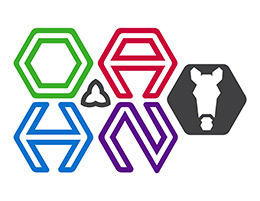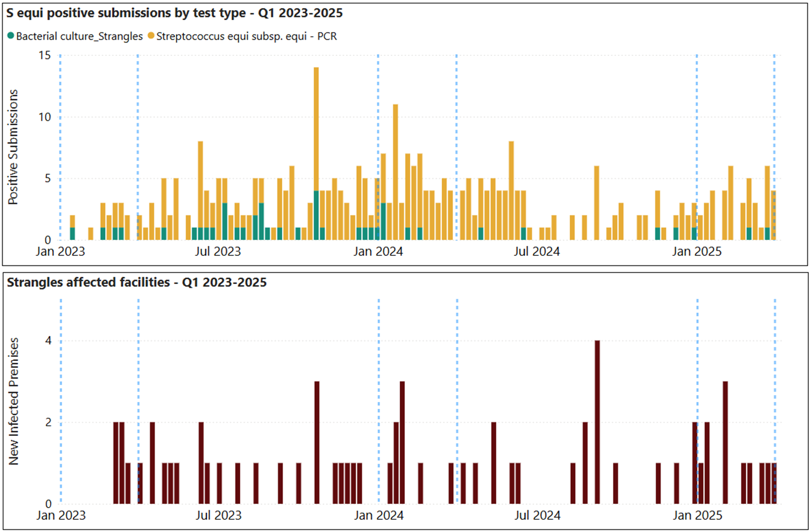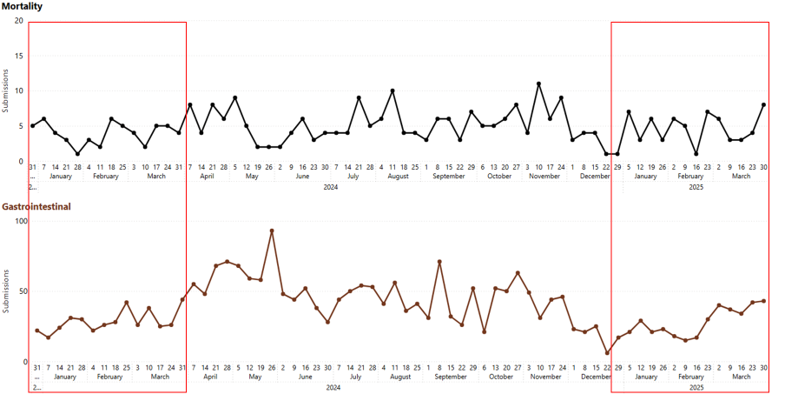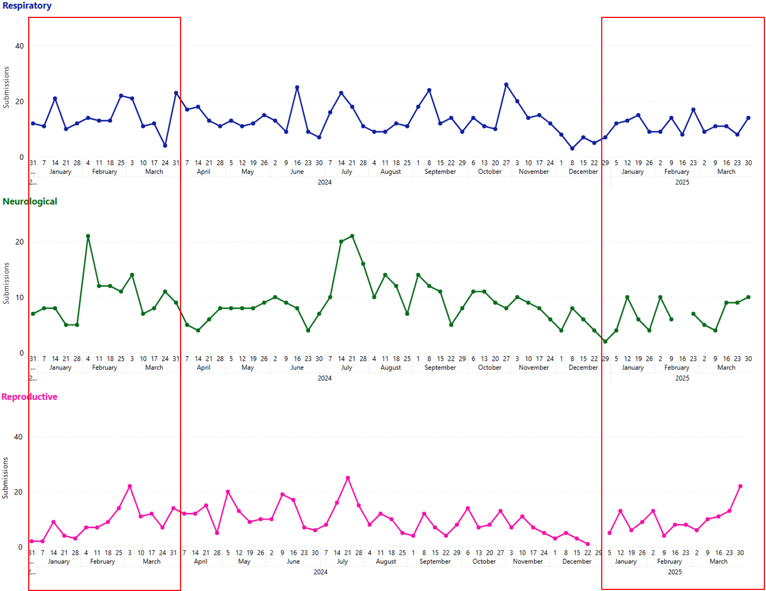Ontario Animal Health Network (OAHN)
Equine Expert Network
Quarterly Veterinary Report
BITS ‘N SNIPS (or “things we talked about on the network call”)
During this quarterly meeting we discussed respiratory outbreaks with only the gammaherpesviruses (EHV-2, EHV-5) isolated.
See the infographic below on gammaherpesviruses for more information.
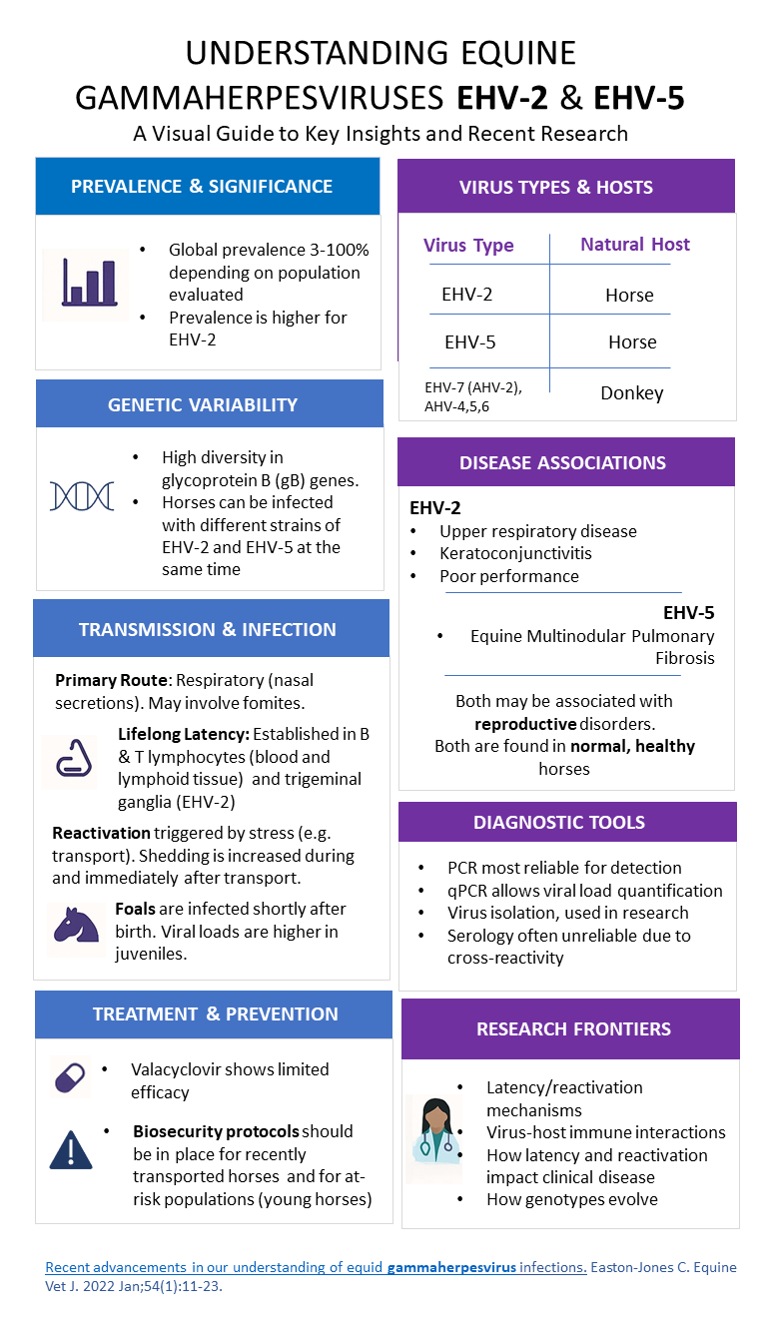
We also discussed the identification of Strongylus vulgaris in recent postmortem examinations:
- 2025 Q1 – Yearling QH filly presented for lethargy and diarrhea. Marked wall thickening of small intestinal segments and fluid filled colon on ultrasound examination. Filly collapsed and died 12 hours after admission. Diagnosis: verminous arteritis of the cranial mesenteric artery (Strongylus vulgaris) and proliferative enteritis due to Lawsonia intracellularis.
- 2024 Q1 – 186 day old WB filly presented for acute profuse diarrhea with no clinical improvement despite treatment. The filly was dull and recumbent and euthanasia was elected. Diagnosis: multiple parasitic infections including cranial mesenteric verminous arteritis with thrombosis secondary to Strongylus vulgaris migration, sepsis and Lawsonia intracellularis.
- 2022 Q4 – 20 mo old Belgian filly died from weakness and starvation. Amongst the findings included numerous migrating larval nematodes (S. vulgaris) in sections of intestinal arteries, intestine and mesenteric lymph nodes
See the infographic below for information on how farm biosecurity in Sweden affects S. vulgaris risk.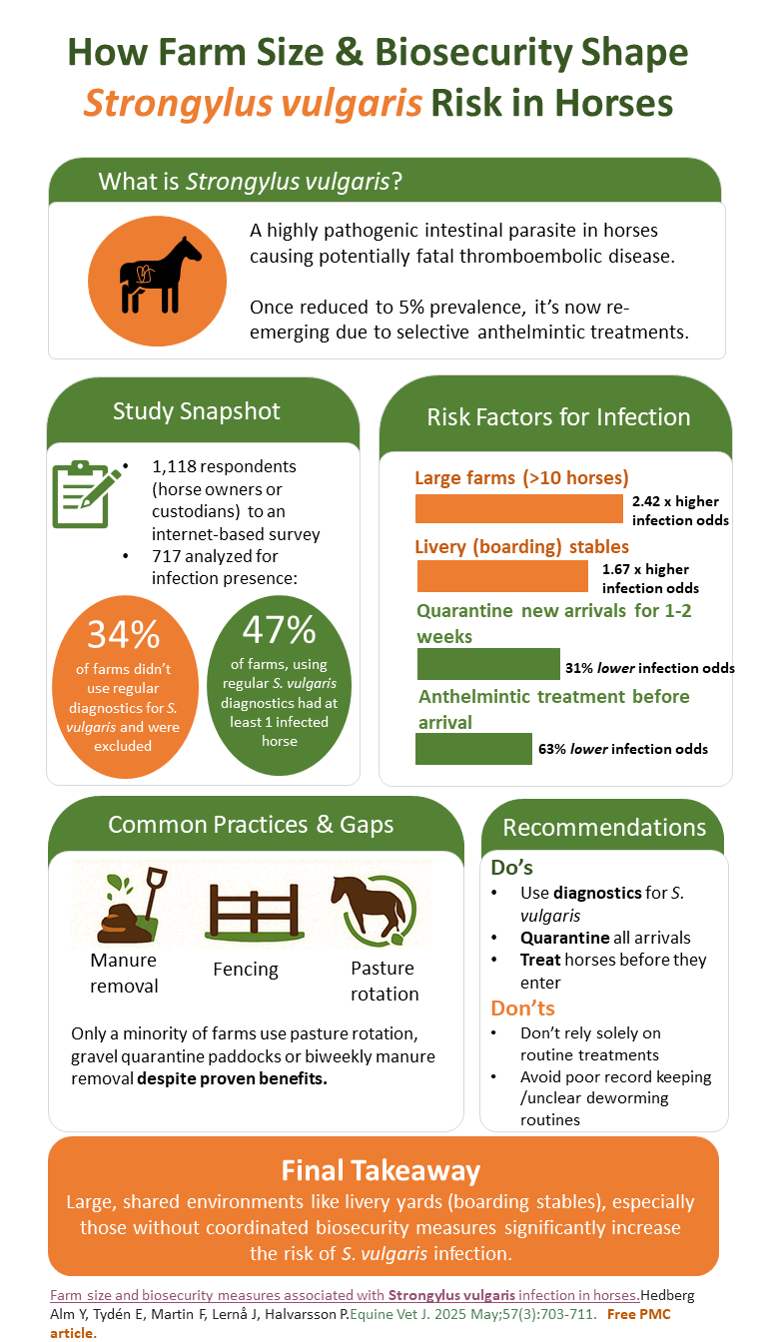
Strangles and EHV-1 Resources
The OAHN Equine network has put together a list of Strangles and EHV-1 resources for veterinarians and owners. They are available at:
- Equine Strangles Resources – Ontario Animal Health Network (oahn.ca)
- Equine Herpesvirus-1 Resources – Ontario Animal Health Network (oahn.ca)
The Ontario map of facilities dealing with Strangles and EHM can be found here:
Equine Disease Tracking Network v 2.1 (arcgis.com)
Strangles and EHM alert notifications are available at:
Network Member Reports
| Southwestern Region
(Melissa McKee) |
A harsh and prolonged winter kept us in the same pattern as Q4 2024 such as impaction colics and traumatic injuries due to slipping on ice. Late in the quarter we found mares difficult to get cycling reproductively. We also had some challenging dystocias early in the foaling season. We saw some mild viral respiratory diseases in racehorses particularly when the young horses arrived back from Florida but were self-limiting. There may have been a few more coffin bone fractures in racehorses this time of year than we’ve seen previously. We are seeing fewer horses likely due to the economy and/or weather. |
| Eastern Ontario
(John Donovan) |
This quarter was fairly quiet. We saw a few impactions but the number was not increased. Considering the extreme winter/cold horses did fairly well. We also saw a few traumatic events (slip on ice) but not more than normal. Our biggest increase was in equine respiratory disease. We had outbreaks of EHV-2 and 5. The barns are being quarantined as it was trickling through each individual horse. A person may have carried it between barns. We have seen typical skin cases and some terrible hair coats as the blankets are being removed. The start to the reproductive season had been very slow but it now starting to come around. We are also expecting a banner season for laminitis |
| Southern Ontario
(Jenna Donaldson) |
We also had a fairly quiet quarter with no notable increase or decrease in any disease/condition. Our numbers of broodmares and foals is fairly stable. Every year there are mares that don’t cycle well early but it didn’t seem to be an increase over previous years. In Jan and Feb it seemed like we had more dystocias, which may be related to having more maiden mares in foal this time of year, but this settled down quickly. As well we had some hip locked foals and foals with contracted tendons, but these conditions have improved during March.
|
| Ontario Veterinary College
(Memo Arroyo) |
We saw a lot of septic foals and nasty infections, We are getting worried about antimicrobial resistant infections. With septic joints, we have been flushing them repeatedly. They improve and then the cell count goes back up and then osteomyelitis develops. Antibiotics like imipenem are being used frequently south of the border. We try to avoid using it here but in some instances we have now had to. Most of the colics we saw this quarter were postpartum mares. Horses with diarrhea are starting to arrive. We had a horse diagnosed with Potomac horse fever, on blood and manure testing, in April which is early. |
| AHL Pathology
(Emily Ratsep) |
|
| OMAFA
(Hannah Golightly & Alison Moore) |
Immediately Notifiable Diseases: Case Reports to OMAFA
Equine Herpesvirus-1: There were 2 facilities affected by EHM due to EHV-1 in Q1. One foal was born weak and died (nNP strain) from Hamilton region (purple box on figure below). 7 horses died from the NP strain in the Regional Municipality of Niagara (green box below).
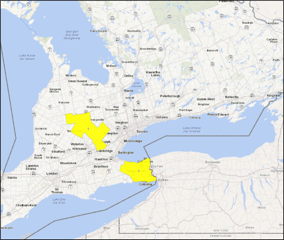 Strangles: During Q1 there were 11 new facilities managing Strangles. There were 25 facilities affected by Strangles in 2024. 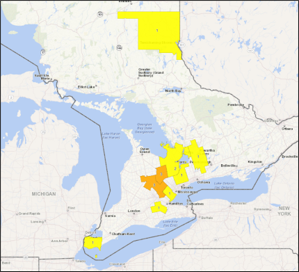
West Nile Virus: No cases this quarter
Eastern Equine Encephalitis virus: No cases the quarter
Equine Influenza: No cases this quarter Q1 Equine Syndromic Surveillance: Graphs of disease syndromes based on samples sent for testing to the Animal Health Laboratory. This information is compiled based on the type of sample, test ordered, and key terms included in the submission history (if provided).
|
Syndromic and AHL Laboratory Data Surveillance
Survey – Key points
- 19 Counties represented
- 64% equine, 18% equine referral practice, 9% equine and food animal, 9% other
- 22% of veterinarians reported working with performance/Competition/Show horses, 22% with pleasure/backyard horses, 18% with foals, breeding and young stock, 18% pleasure and backyard horses, 14% with draft horses, 14% racehorses, 12% with mules/donkeys, and 4% with buggy horses.
- Increases in Q1 were noted for (foal): Strangles, neurologic disease of unknown origin, dystocia due to hip lock and/or contracted tendons, clinical vitamin E/Se deficiency, weak neonate.
- Increases in Q1 were noted for (adult): FUO some suspected to be respiratory in multiple barns (nasal swabs neg), vaccine reactions (EHV-2 and EHV-5 (cough, pharyngitis, mild fever), mild respiratory outbreaks in racehorses (mainly 2 yo), Strangles, colic (impactions, medical, strange colic lesions), rain rot in blanketed horses, lice, allergic dermatitis, foaling accidents (RV fistula, perineal lacerations), winter laminitis, EMS, Anaplasmosis.
New conditions or those without a diagnosis:
- A few odd fevers of unknown origins
- Horses going off feed even with normal gastroscopy/bloodwork/clinical-oral exam, good stable management and hay.
- 2yo STB, chronic poor body condition, low WBC/RBC but labs otherwise normal, FEC 500-1000 on 4 tests for the last 6 months in spite of aggressive deworming protocol and rechecks.
- Two cases of neurological acute disease, no specific diagnosis.
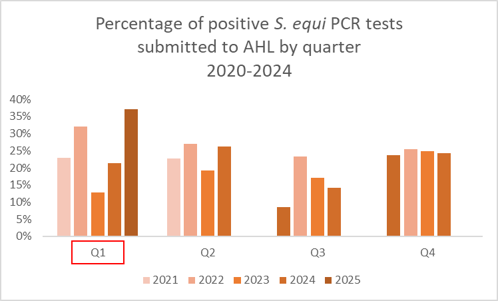
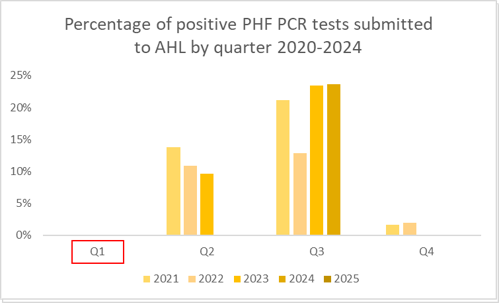
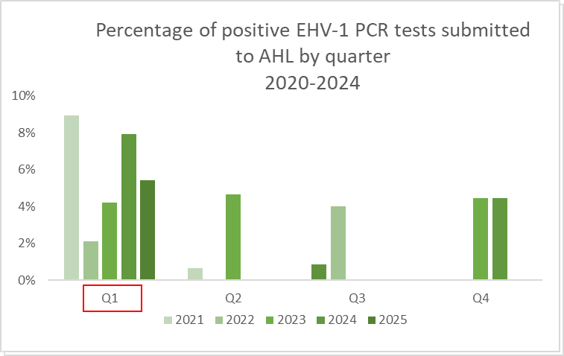
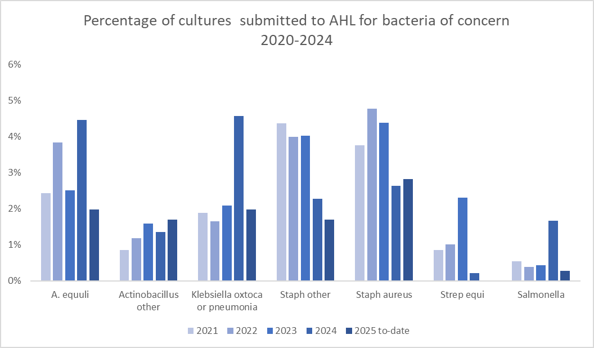
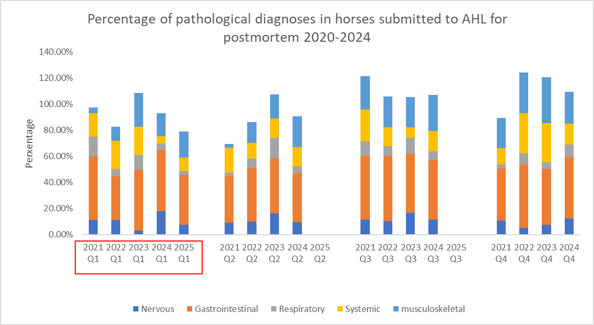
Equine Research from Ontario and Around the World
Researchers in Ontario
The effects of a plant-based and a plant- and marine-based n-3 oil supplement on behavioral reactivity, heart rate variability, and plasma fatty acid profile in young healthy horses.Hartwig S, Rankovic A, McCrae P, Gagliardi K, Burron S, Ellis J, Ma DWL, Shoveller AK.J Anim Sci. 2025 Jan 4;103:skaf117. doi: 10.1093/jas/skaf117.PMID: 40202435 Free PMC article.
Predictors and barriers for biosecurity uptake and risk understanding among Ontario horse owners.Germann JA, O’Sullivan TL, Greer AL, Spence KL.Can Vet J. 2025 Mar;66(3):288-297.
A retrospective survey of equine ocular diseases evaluated at a referral hospital in Ontario (2011 to 2021).Ing ST, Pinard CL, James-Jenks EM, Leis ML.Can Vet J. 2025 Mar;66(3):308-317.
A survey of welfare problems associated with transporting horses by road in Germany (2022-2024).May A, Riley CB, Scharre A, Zablotski Y, Padalino B.Vet J. 2025 Mar 5;311:106322. doi: 10.1016/j.tvjl.2025.106322. Online ahead of print.PMID: 40054726 Free article.
Longitudinal Evaluation of Vitamin D, Parathyroid Hormone, Antimicrobial Peptides, and Immunomodulatory Genes in Hospitalized Foals.Kamr AM, Bartish C, Summers J, Horton J, Hostnik LD, Orr K, Browne N, Dembek KA, Saliba C, Gomez DE, Toribio RE.J Vet Intern Med. 2025 Mar-Apr;39(2):e70012. doi: 10.1111/jvim.70012.PMID: 40008921 Free PMC article.
Changes in bacterial viability after preparation and storage of fecal microbiota transplantation solution using equine feces.Arantes JA, Di Pietro R, Ratté M, Arroyo LG, Leclère M, Costa MC.PeerJ. 2025 Feb 20;13:e18860. doi: 10.7717/peerj.18860. eCollection 2025.PMID: 39989751 Free PMC article.
Mild radiographic abnormalities of thoracolumbar spinous processes are not associated with decreased performance in 100 Warmblood jumping horses in active competition.Kerbert MP, le Jeune SS, Philips KL, Shaw KL, Erickson CA, Espinosa-Mur P.J Equine Vet Sci. 2025 Apr;147:105366. doi: 10.1016/j.jevs.2025.105366. Epub 2025 Feb 11.
A wicked problem: Systemic issues surrounding Canadian equestrian dressage and dressage horse welfare.Ross M, Proudfoot K, Merkies K, Lundgren C, Ritter C.Anim Welf. 2025 Feb 10;34:e11. doi: 10.1017/awf.2025.2. eCollection 2025.PMID: 39935780 Free PMC article.
Whole-genome sequencing of Salmonella serovars isolated from diarrheic and non-diarrheic foals.Basso RM, Cerri FM, Possebon FS, Braga PRC, Casas MRT, Oliveira-Filho JP, Araújo Júnior JP, Ribeiro MG, Arroyo LG, Borges AS.J Vet Diagn Invest. 2025 Mar;37(2):363-366. doi: 10.1177/10406387251316314. Epub 2025 Feb 10.PMID: 39930357 Free PMC article.
The effect of dietary camelina, flaxseed, and canola oil supplementation on skin fatty acid profile and immune and inflammatory responses in healthy adult horses.Hartwig S, Burron S, Richards T, Rankovic A, Ma DWL, Pearson W, Ellis J, Trevizan L, Seymour DJ, Shoveller AK.J Anim Sci. 2025 Jan 4;103:skaf025. doi: 10.1093/jas/skaf025.PMID: 39901745 Free PMC article.
Effect of rapid and slow intravenous injection of sodium penicillin on arterial blood pressure in isoflurane-anesthetized horses during surgery.Henderson ARP, Valverde A, Marchiori J, Tisotti T, Torrent A, Côté N, Gomez DE.Vet Anaesth Analg. 2025 Mar-Apr;52(2):200-207. doi: 10.1016/j.vaa.2025.01.001. Epub 2025 Jan 6.
Bladder rupture in late-pregnancy mares: Four cases.Salcedo-Jiménez R, Kenney DG, Dubois MS.J Equine Vet Sci. 2025 Mar;146:105365. doi: 10.1016/j.jevs.2025.105365. Epub 2025 Jan 23.
Effects of anesthetic protocol, procedure, and recovery stall and interval on the quality of recovery in repeatedly anesthetized horses.Henderson ARP, Valverde A, Koenig J, Sears W.Can J Vet Res. 2025 Jan;89(1):17-25.PMID: 39744466 Free PMC article.
Effect of a dietary nutraceutical “STRUCTURE-Joint” on response of horses to intra-articular challenge with IL-1: implications for tissue adaptation to stress.Korac L, Golestani N, MacNicol J, Souccar-Young J, Witherspoon S, Wildish A, Topfer S, Pearson W.Transl Anim Sci. 2024 Dec 7;8:txae172. doi: 10.1093/tas/txae172. eCollection 2024.PMID: 39713786 Free PMC article.
How well can you tell? Success of human categorisation of horse behavioural responses depicted in media.Merkies K, Trudel K.Anim Welf. 2024 Nov 11;33:e50. doi: 10.1017/awf.2024.55. eCollection 2024.PMID: 39600357 Free PMC article.
RNA Sequencing of Sperm from Healthy Cattle and Horses Reveals the Presence of a Large Bacterial Population.Navarrete-López P, Asselstine V, Maroto M, Lombó M, Cánovas Á, Gutiérrez-Adán A.Curr Issues Mol Biol. 2024 Sep 19;46(9):10430-10443. doi: 10.3390/cimb46090620.PMID: 39329972 Free PMC article.
Researchers around the world
Behaviour
Exploring factors that influence the behavior response to novel object tests in young thoroughbred horses: investigating sex, test site and auction history.Klitzing L, Kirsch K, Schindler M, Merle R, Hoffmann G, Thöne-Reineke C, Wiegard M.Front Vet Sci. 2025 Jan 15;11:1478350. doi: 10.3389/fvets.2024.1478350. eCollection 2024.PMID: 39881719 Free PMC article.
Healthy as a Horse? Characterising the UK and Ireland’s Horse Owners, Their Horses, and Owner-Reported Health and Behavioural Issues.Watson WL, MacKay JRD, Dwyer CM.Animals (Basel). 2025 Jan 31;15(3):397. doi: 10.3390/ani15030397.PMID: 39943167 Free PMC article.
No More Evasion: Redefining Conflict Behaviour in Human-Horse Interactions.O’Connell E, Dyson S, McLean A, McGreevy P.Animals (Basel). 2025 Jan 31;15(3):399. doi: 10.3390/ani15030399.PMID: 39943169 Free PMC article.
Dentistry
The challenge of assessing dental pain in horses.Kennedy RS.Vet Rec. 2025 Feb 1;196(3):111-113. doi: 10.1002/vetr.5188.
Dermatology
Microbiological effect of topically applied Weissella cibaria on equine pastern dermatitis.Styková E, Valocký I, Kačírová J, Fecskeová LK.Front Vet Sci. 2025 Jan 6;11:1493756. doi: 10.3389/fvets.2024.1493756. eCollection 2024.PMID: 39834920 Free PMC article.
Safety and immunogenicity of a sarcoid vaccine in horses.Jacob O, Hause B, Peters-Smith K, Adam EN, Page AE, Floyd C, Tucker C, Eertink LG, Wang D, Li F.J Equine Vet Sci. 2025 Mar;146:105381. doi: 10.1016/j.jevs.2025.105381. Epub 2025 Feb 10.
Skin Barrier in Normal and Allergic Horses: What Do We Know?Marsella R.Vet Sci. 2025 Jan 24;12(2):91. doi: 10.3390/vetsci12020091.PMID: 40005851 Free PMC article.
High prevalence of Chorioptes bovis: an important factor in chronic progressive lymphedema in Belgian draft horses.Brys M, Claerebout E, Saey V, Chiers K.Vet Res Commun. 2025 Mar 5;49(3):129. doi: 10.1007/s11259-025-10695-y.PMID: 40042772 Free PMC article.
Gastroenterology
Equine colic: A comprehensive overview of the sonographic evaluation, diagnostic criteria, and management of different categories.Tharwat M, Al-Sobayil F.Open Vet J. 2025 Mar;15(3):1116-1139. doi: 10.5455/OVJ.2025.v15.i3.5. Epub 2025 Mar 31.PMID: 40276205 Free PMC article.
Fecal microbiota changes associated with pathogenic and non-pathogenic diarrheas in foals.Shi Y, Maga EA, Mienaltowski MJ.BMC Res Notes. 2025 Jan 23;18(1):34. doi: 10.1186/s13104-025-07110-9.PMID: 39849534 Free PMC article.
Abdominal Ultrasonography in Healthy Female Standard Donkeys.Accorroni L, Bazzano M, Marchegiani A, Spaterna A, Laus F.Animals (Basel). 2025 Jan 8;15(2):129. doi: 10.3390/ani15020129.PMID: 39858129 Free PMC article.
Investigating the potential immunomodulatory effects of commercial oral probiotic supplements on equine gastrointestinal tract barrier function.Żak-Bochenek A, Żebrowska-Różańska P, Bajzert J, Łaczmański Ł, Szponar B, Siwińska N, Gładysz K, Sikorska K, Chełmońska-Soyta A.Front Immunol. 2025 Jan 21;15:1487664. doi: 10.3389/fimmu.2024.1487664. eCollection 2024.PMID: 39906737 Free PMC article.
Can All Behavioral Problems Be Blamed on Equine Gastric Ulcer Syndrome?Sykes B, Lovett A.Animals (Basel). 2025 Jan 22;15(3):306. doi: 10.3390/ani15030306.PMID: 39943076 Free PMC article.
Oxytocin in horse saliva: validation of a highly sensitive assay and a pilot report about changes in equine gastric ulcer syndrome.Botía M, Muñoz-Prieto A, Martínez-Subiela S, Martín-Cuervo M, Hansen S, Manteca X, Cerón JJ, López-Arjona M.BMC Vet Res. 2025 Feb 22;21(1):90. doi: 10.1186/s12917-025-04569-3.PMID: 39987089 Free PMC article.
Medical treatment of sand enteropathy with psyllium, magnesium sulphate and paraffin oil in 54 Western Australian equids.Entwisle IG, McConnell EJ.Aust Vet J. 2025 Apr;103(4):159-162. doi: 10.1111/avj.13406. Epub 2025 Feb 23.
Genetic
Biochemical characterization of collagen I in Warmblood Fragile Foal Syndrome horse lysyl hydroxylase 1 mutation.Ishikawa Y, Tufa SF, Keene DR, Bächinger HP, Winand NJ.MicroPubl Biol. 2025 Jan 3;2025:10.17912/micropub.biology.001399. doi: 10.17912/micropub.biology.001399. eCollection 2025.PMID: 39839713 Free PMC article.
Equus mitochondrial pangenome reveals independent domestication imprints in donkeys and horses.Du W, Sun Q, Hu S, Yu P, Kan S, Zhang W.Sci Rep. 2025 Feb 25;15(1):6803. doi: 10.1038/s41598-025-91564-1.PMID: 40000832 Free PMC article.
The value of using multilevel performances (from recreational to international) to the genetic evaluation for show jumping performance in Warmblood horses.Chapard L, Gorssen W, Meyermans R, Hooyberghs K, Buys N, Janssens S.Animal. 2025 Mar;19(3):101455. doi: 10.1016/j.animal.2025.101455. Epub 2025 Feb 5.PMID: 40014903 Free article.
Genetic Evaluation of Barrel Racing Performance in Quarter Horses.Santana ML, Franco TGB, Bignardi AB.J Anim Breed Genet. 2025 Mar 1. doi: 10.1111/jbg.12934. Online ahead of print.
Geriatric Medicine
A structured exercise regimen enhances autonomic function compared to unstructured physical activities in geriatric horses.Sanigavatee K, Poochipakorn C, Huangsaksri O, Vichitkraivin S, Pakdeelikhit S, Chotiyothin W, Wongkosoljit S, Wonghanchao T, Chanda M.Sci Rep. 2025 Jan 20;15(1):2493. doi: 10.1038/s41598-025-86679-4.PMID: 39833241 Free PMC article.
Characterization and comparison of fecal microbiota in horses with pituitary pars intermedia dysfunction and age-matched controls.Wang W, Gibson J, Horsman S, Mikkelsen D, Bertin FR.J Vet Intern Med. 2025 Jan-Feb;39(1):e17288. doi: 10.1111/jvim.17288.PMID: 39853825 Free PMC article.
Time but not storage of equine plasma in silicate-coated tubes affects adrenocorticotropic hormone stability.Johnston TJ, Stewart AJ, Dryburgh EL, Bertin FR.Am J Vet Res. 2025 Feb 6;86(4):ajvr.24.11.0362. doi: 10.2460/ajvr.24.11.0362. Print 2025 Apr 1.PMID: 39913999 Free article.
Hematology
Essential and risk elements in horses affect haematology, serum biochemistry and oxidative status parameters.Halo M Jr, Kirchner R, Tirpák F, Slanina T, Tokárová K, Kováčik A, Miškeje M, Greń A, Formicki G, Halo M, Madeddu R, Massányi P.Sci Rep. 2025 Jan 28;15(1):3489. doi: 10.1038/s41598-025-87908-6.PMID: 39875518 Free PMC article.
Horse Racing
Post-mortem computed tomography features associated with fracture of the fetlock joint in racing Thoroughbreds.Beck C, Hitchens PL, Whitton RC.Equine Vet J. 2025 Feb 10. doi: 10.1111/evj.14465. Online ahead of print.
The occurrence of low thyroxine concentrations and response to thyrotropin-releasing hormone using equine and canine assays in a population of Standardbred racehorses in Prince Edward Island, Canada.MacMillan KM, Burns JJ, John E, Clancey N, Stull JW.J Equine Vet Sci. 2025 Apr;147:105400. doi: 10.1016/j.jevs.2025.105400. Epub 2025 Feb 21.
The ability to race barefoot is a heritable trait in Standardbred and Coldblooded trotters.Berglund P, Andonov S, Jansson A, Olsson C, Lundqvist T, Strandberg E, Eriksson S.Genet Sel Evol. 2025 Feb 25;57(1):8. doi: 10.1186/s12711-025-00958-2.PMID: 40000964 Free PMC article.
Linkage of jockey falls and injuries with racehorse injuries and fatalities in Thoroughbred flat racing in Victoria, Australia.Morrice-West AV, Thomas M, Wong ASM, Flash M, Whitton RC, Hitchens PL.Front Vet Sci. 2025 Feb 13;11:1481016. doi: 10.3389/fvets.2024.1481016. eCollection 2024.PMID: 40018508 Free PMC article.
Infectious Disease
Equine Rotavirus A Outbreaks in Ireland (2023-2024): An Epidemiological Investigation and Virus Genotyping.Cullinane A, Garvey M, Dayot L, Lukaseviciute G.Viruses. 2025 Mar 31;17(4):511. doi: 10.3390/v17040511.PMID: 40284954 Free PMC article.
Phenotypic and genotypic characterization of antimicrobial resistance and virulence profiles of Salmonella enterica serotypes isolated from necropsied horses in Kentucky.Kabir A, Kelley WG, Glover C, Erol E, Helmy YA.Microbiol Spectr. 2025 Mar 4;13(3):e0250124. doi: 10.1128/spectrum.02501-24. Epub 2025 Jan 23.PMID: 39846771 Free PMC article.
The peculiar characteristics and advancement in diagnostic methodologies of influenza A virus.Raza MA, Ashraf MA, Amjad MN, Din GU, Shen B, Hu Y.Front Microbiol. 2025 Jan 7;15:1435384. doi: 10.3389/fmicb.2024.1435384. eCollection 2024.PMID: 39839109 Free PMC article.
Detection and genetic characterization of equine viruses in Sweden using viral metagenomics.Blomström AL, Källse A, Riihimäki M.BMC Vet Res. 2025 Feb 27;21(1):119. doi: 10.1186/s12917-025-04613-2.PMID: 40011862 Free PMC article.
Eastern equine encephalitis virus: Pathogenesis, immune response, and clinical manifestations.Parashar B, Malviya R, Sridhar SB, Wadhwa T, Talath S, Shareef J.Infect Med (Beijing). 2025 Jan 17;4(1):100167. doi: 10.1016/j.imj.2025.100167. eCollection 2025 Mar.PMID: 40026316 Free PMC article. Review.
Dietary supplementation of new-born foals with free nucleotides positively affects neonatal diarrhoea management.Penazzi L, Pagliara E, Nervo T, Ala U, Bertuglia A, Romano G, Hattab J, Tiscar PG, Bergagna S, Pagliasso G, Antoniazzi S, Cavallarin L, Valle E, Prola L.Ir Vet J. 2025 Mar 1;78(1):7. doi: 10.1186/s13620-025-00294-3.PMID: 40025599 Free PMC article.
Risk Factors and Long-Term Outcomes in Horses After the 2021 Outbreak of Equine Herpesvirus 1 Myeloencephalopathy, Valencia, Spain.de la Cuesta-Torrado M, Velloso Alvarez A, Santiago-Llorente I, Armengou L, Nieto F, Ríos J, Cruz-López F, Jose-Cunilleras E.J Vet Intern Med. 2025 Mar-Apr;39(2):e70040. doi: 10.1111/jvim.70040.PMID: 40055829 Free PMC article.
Investigation of the Blood Microbiome in Horses With Fever of Unknown Origin.Sun Y, Yu YT, Castillo XO, Anderson R, Wang M, Sun Q, Tallmadge R, Sams K, Reboul G, Zehr J, Brown J, Wang X, Marra N, Stanhope B, Grenier J, Pusterla N, Divers T, Mittel L, Goodman LB.Vet Med Sci. 2025 Mar;11(2):e70272. doi: 10.1002/vms3.70272.PMID: 40065594 Free PMC article.
Risk factors for tick infestation and equine Piroplasmosis infection among draught horses in France.Nadal C, Chanet C, Delaunay C, Pitel PH, Marsot M, Bonnet SI.Ticks Tick Borne Dis. 2025 Mar 17;16(3):102468. doi: 10.1016/j.ttbdis.2025.102468. Online ahead of print.PMID: 40101594 Free article.
Metabolic Disease
Effect of pergolide treatment on insulin dysregulation in horses and ponies with pituitary pars intermedia dysfunction.Galinelli NC, Bamford NJ, Erdody ML, Mackenzie SA, Warnken T, Harris PA, Sillence MN, Bailey SR.Equine Vet J. 2025 Feb 18. doi: 10.1111/evj.14468. Online ahead of print.
Initial investigation into the metabolic effects of intra-articular betamethasone on normal and insulin dysregulated horses.Page AE, Rauber-Ramos AM, Humiston M, McPeek JL, Adam EN.J Equine Vet Sci. 2025 Apr;147:105404. doi: 10.1016/j.jevs.2025.105404. Epub 2025 Feb 22.
Effect of Phenylbutazone Administration on Insulin Sensitivity in Horses With Insulin Dysregulation.Kemp KL, Yuen NKY, Skinner JE, Bertin FR.J Vet Intern Med. 2025 Mar-Apr;39(2):e70028. doi: 10.1111/jvim.70028.PMID: 40011055 Free PMC article.
Effectiveness of acupuncture for equine laminitis: Systematic review and meta-analysis.Fikri F, Purnomo A, Maslamama ST, Purnama MTE.Vet World. 2025 Jan;18(1):60-66. doi: 10.14202/vetworld.2025.60-66. Epub 2025 Jan 9.PMID: 40041523 Free PMC article. Review.
The Effect of Season and Breed on Hypothalamic-Pituitary-Adrenal Axis Hormones, Metabolic Hormones, and Oxidative Markers in Ponies and Horses.Vaughn SA, Lemons MB, Hart KA.J Vet Intern Med. 2025 Mar-Apr;39(2):e70047. doi: 10.1111/jvim.70047.PMID: 40048369 Free PMC article.
Corticosteroid Administration Enhances the Glycemic, Insulinemic, and Incretin Responses to a High-Protein Mixed Meal in Adult Horses.Palmer AT, Watts MR, Timko KJ, Pinnell EF, Keefer KA, Gorman O, Hostnik LD, Burns TA.J Vet Intern Med. 2025 Mar-Apr;39(2):e17305. doi: 10.1111/jvim.17305.PMID: 40062690 Free PMC article.
Current understanding of insulin dysregulation and its relationship with carbohydrate and protein metabolism in horses.Loos CMM, Urschel KL.Domest Anim Endocrinol. 2025 Mar 8;92:106940. doi: 10.1016/j.domaniend.2025.106940. Online ahead of print.PMID: 40073599
Association Between Adrenocorticotropic Hormone Concentration and Clinical Signs of Pituitary Pars Intermedia Dysfunction in Swiss and Austrian Equids.Fouché N, Doras C, Schüpbach-Regula G, Scherer A, Freudenschuss B, Gerber V.J Vet Intern Med. 2025 Mar-Apr;39(2):e70008. doi: 10.1111/jvim.70008.PMID: 40095750 Free PMC article.
Miscellaneous
Strychnine poisoning in nontarget species in western Canada: A retrospective case series (2014 to 2023).Cowan VE.Can Vet J. 2025 Feb;66(2):168-176.PMID: 39898164 Free PMC article.
Antimicrobial use and prescribing practices by equine veterinarians in Australia: Insights into reproduction, dentistry, compounding and use for nonbactericidal effects.Hardefeldt LY, Thomas K, Begg L.Aust Vet J. 2025 Feb 25. doi: 10.1111/avj.13428. Online ahead of print.
Experiences of End-of-Life Decision-Making in Equine Veterinary and Charity Teams.Cameron A, Geldard M, Mair T, England G, Burford J, Freeman S, Pollock K, Wilson E.Animals (Basel). 2025 Feb 26;15(5):678. doi: 10.3390/ani15050678.PMID: 40075960 Free PMC article.
The Systemic Inflammatory Response Syndrome and Predictors of Infection and Mortality in 1068 Critically Ill Newborn Foals.Wilkins PA, Wong D, Slovis NM, Collins N, Barr BS, MacKenzie C, De Solis CN, Castagnetti C, Mariella J, Burns T, Perkins G, Delvescovo B, Sanchez LC, Kemper AM, Magdesian KG, Bedenice D, Taylor SD, Gold J, Dunkel B, Pranzo G, Constable PD.J Vet Intern Med. 2025 Mar-Apr;39(2):e70004. doi: 10.1111/jvim.70004.PMID: 40091577 Free PMC article.
Muscle
Chronic idiopathic myopathy in Icelandic horses: A case series.Hansen S, Hopster-Iversen C, Berg L, Fjeldborg J, Massey C, Piercy RJ, Carstensen H.Equine Vet J. 2025 Apr 24. doi: 10.1111/evj.14519. Online ahead of print.
Assessment of tree-associated atypical myopathy risk factors in Acer pseudoplatanus (sycamore) seeds and leaves.González-Medina S, Hyde C, Chang YM, Piercy RJ.Equine Vet J. 2025 Jan 25. doi: 10.1111/evj.14475. Online ahead of print.
The Role of Nutrition in Managing Muscle Disorders.Pagan JD, Valberg SJ.Vet Clin North Am Equine Pract. 2025 Apr;41(1):151-163. doi: 10.1016/j.cveq.2024.11.007. Epub 2025 Jan 27.PMID: 39875249 Review.
Unravelling Faecal Microbiota Variations in Equine Atypical Myopathy: Correlation with Blood Markers and Contribution of Microbiome.François AC, Cesarini C, Taminiau B, Renaud B, Kruse CJ, Boemer F, van Loon G, Palmers K, Daube G, Wouters CP, Lecoq L, Gustin P, Votion DM.Animals (Basel). 2025 Jan 26;15(3):354. doi: 10.3390/ani15030354.PMID: 39943124 Free PMC article.
Nutrition
A Meta-Analysis on Quantitative Sodium, Potassium and Chloride Metabolism in Horses and Ponies.Maier I, Kienzle E.Animals (Basel). 2025 Jan 13;15(2):191. doi: 10.3390/ani15020191.PMID: 39858191 Free PMC article. Review.
Ophthalmology
Uveitis and blindness in a closed herd of Equidae following leptospiral infection.Gerras J, Young K, Roberts D, Waldman G, Salmon JH, Gilger BC.Front Vet Sci. 2025 Jan 6;11:1504990. doi: 10.3389/fvets.2024.1504990. eCollection 2024.PMID: 39834922 Free PMC article.
Orthopedics
Relationship between back pain and poor performance in show jumping athletic horses.Shokry M, Ali LB, El-Sharkawy M.Open Vet J. 2025 Mar;15(3):1480-1487. doi: 10.5455/OVJ.2025.v15.i3.37. Epub 2025 Mar 31.PMID: 40276202 Free PMC article.
Equine temporomandibular joint diseases: A systematic review.Jasiński T, Turek B, Kaczorowski M, Brehm W, Skierbiszewska K, Domino M.Equine Vet J. 2025 Jan 24. doi: 10.1111/evj.14462. Online ahead of print.
Local anesthetics and antibiotics display synergistic and antagonistic drug interactions against pathogens causing septic arthritis in horses.Adler DMT, Nielsen AT, Olsen C, Verwilghen D, Damborg P, Olsen RH.Am J Vet Res. 2025 Feb 19;86(5):ajvr.24.08.0214. doi: 10.2460/ajvr.24.08.0214. Print 2025 May 1.PMID: 39970538 Free article.
Spondylosis in Horses: Clinical Features, Diagnostic Imaging Findings, Treatment and Outcome in 13 Horses.de Secondi C, Cantatore F, Marcatili M, Biggi M, Withers J, de Zani D, Zani D.Vet Med Sci. 2025 Mar;11(2):e70196. doi: 10.1002/vms3.70196.PMID: 40109022 Free PMC article.
A Safety and Efficacy Study of a Synthetic Biolubricant in an Equine Model of Post-Traumatic Osteoarthritis.Luedke LK, Seabaugh KA, Cooper BG, Snyder BD, Wimmer MA, McIlwraith CW, Barrett MF, Kawcak CE, Grinstaff MW, Goodrich LR.Animals (Basel). 2025 Feb 1;15(3):404. doi: 10.3390/ani15030404.PMID: 39943174 Free PMC article.
Nutrition
A Meta-Analysis on Quantitative Sodium, Potassium and Chloride Metabolism in Horses and Ponies.Maier I, Kienzle E.Animals (Basel). 2025 Jan 13;15(2):191. doi: 10.3390/ani15020191.PMID: 39858191 Free PMC article. Review.
Ophthalmology
Uveitis and blindness in a closed herd of Equidae following leptospiral infection.Gerras J, Young K, Roberts D, Waldman G, Salmon JH, Gilger BC.Front Vet Sci. 2025 Jan 6;11:1504990. doi: 10.3389/fvets.2024.1504990. eCollection 2024.PMID: 39834922 Free PMC article.
Respiratory
Yearling laryngeal function grades II.2 and below are not associated with reduced performance.Hardwick JL, Ahern BJ, Crawford KL, Allen KJ, Anderson BH, Rose KJ, Franklin SH.Equine Vet J. 2025 Jan 21. doi: 10.1111/evj.14452. Online ahead of print.
Respiratory viruses affecting health and performance in equine athletes.Frippiat T, van den Wollenberg L, van Erck-Westergren E, van Maanen K, Votion DM.Virology. 2025 Feb;603:110372. doi: 10.1016/j.virol.2024.110372. Epub 2024 Dec 24.
Investigation of the frequency and selected prevalence factors of equid alphaherpesvirus 4 viremia in horses with acute onset of fever and respiratory signs.Pusterla N, Barnum S, Lawton K, Craig B, James K.J Vet Diagn Invest. 2025 Mar;37(2):349-353. doi: 10.1177/10406387241308080. Epub 2025 Jan 28.PMID: 39876028 Free PMC article.
Association between fungal detection, airways inflammation and diagnosis of moderate to severe asthma in horses.Barbazanges P, Couroucé A, Le Digarcher G, Cardwell JM, Schmitt E, Toquet MP, Lemonnier LC, Richard EA.Equine Vet J. 2025 Jan 29. doi: 10.1111/evj.14470. Online ahead of print.
Pulmonary disposition and pharmacokinetics of a single oral dose of chloramphenicol in healthy fasted adult horses.Dedecker L, Ceriotti S, Mora-Pereira M, Knych HK, Zuber E, Lascola KM.Am J Vet Res. 2025 Feb 6;86(4):ajvr.24.08.0223. doi: 10.2460/ajvr.24.08.0223. Print 2025 Apr 1.PMID: 39914007 Free article.
Investigation of the role of exercise in the detection of selected respiratory pathogens from nose wipes collected from healthy horses.Wright CA, Lawton K, Barnum S, Craig BW, Farwell BR, Blea J, McCook C, Pusterla N.J Equine Vet Sci. 2025 Mar;146:105377. doi: 10.1016/j.jevs.2025.105377. Epub 2025 Feb 8.
Molecular Assessment of Plasma Concentrations of Selected Adipokines and IL-8 in Horses with Back Pain and Comorbid Asthma-Based on Clinical Cases.Nowicka B, Polkowska I, Zeliszewska-Duk P, Torres A, Duk M.Animals (Basel). 2025 Jan 22;15(3):310. doi: 10.3390/ani15030310.PMID: 39943080 Free PMC article.
Use of inhaled ciclesonide for treatment of moderate asthma in Thoroughbred racehorses.Sanz MG, Jellen G, Cody L, Bergsma J, Cha M, Kogan C, Kordas G, Bayly WM, Leguillette R.J Vet Intern Med. 2025 Mar-Apr;39(2):e17267. doi: 10.1111/jvim.17267.PMID: 39945569 Free PMC article.
Redox Biomarker Variations With Severity of Asthma in Horses Across Different Sample Types.Hansen S, Otten ND, Ceron JJ, González-Arostegui LG, Peres-Rubio C.J Vet Intern Med. 2025 Mar-Apr;39(2):e70031. doi: 10.1111/jvim.70031.PMID: 40035177 Free PMC article.
Respiratory Rate Recovery After Submaximal Lunging Exercise Is Delayed in Asthmatic Horses with Neutrophilic Airway Inflammation.Röschmann J, Naef J, Doras C, Gerber V.Animals (Basel). 2025 Mar 2;15(5):713. doi: 10.3390/ani15050713.PMID: 40075996 Free PMC article.
Overground endoscopic examination following laryngeal tie-forward in horses with dorsal displacement of the soft palate.Barnett TP, Colgate VA, Robinson N, Smith LCR, Palmer L, Barakzai SZ.Vet Surg. 2025 Mar 18. doi: 10.1111/vsu.14245. Online ahead of print.
Sports medicine
Equine adult, fetal and ESC-tenocytes have differential migratory, proliferative and gene expression responses to factors upregulated in the injured tendon.Beaumont RE, Smith EJ, David C, Paterson YZ, Faull E, Guest DJ.Cells Dev. 2025 Mar;181:204003. doi: 10.1016/j.cdev.2025.204003. Epub 2025 Feb 8.PMID: 39929423 Free article.
The Challenge of Defining Laterality in Horses: Is It Laterality or Just Asymmetry?Haussler KK, le Jeune SS, MacKechnie-Guire R, Latif SN, Clayton HM.Animals (Basel). 2025 Jan 21;15(3):288. doi: 10.3390/ani15030288.PMID: 39943060 Free PMC article. Review.
Dynamic Adaptation of Hematological Parameters, Albumin, and Non-Esterified Fatty Acids in Saddlebred and Standardbred Horses During Exercise.Piccione G, Arfuso F, Giudice E, Aragona F, Pugliatti P, Panzera MF, Zumbo A, Monteverde V, Bartolo V, Barbera A, Giannetto C.Animals (Basel). 2025 Jan 21;15(3):300. doi: 10.3390/ani15030300.PMID: 39943070 Free PMC article.
Biomechanical Assessment of the Collateral Ligament of the Distal Interphalangeal Joint of the Horse Following Alterations to the Palmar Angle-A Cadaveric Study.Colla S, Johnson JW, McGilvray KC, Zanotto GM, Seabaugh KA.Animals (Basel). 2025 Feb 1;15(3):406. doi: 10.3390/ani15030406.PMID: 39943176 Free PMC article.
In vivo effects of cold therapy and bandaging on core temperatures of equine superficial and deep digital flexor tendons.McCarthy RD, Ordóñez HJ, Semevolos SA.Vet Surg. 2025 Apr;54(3):470-477. doi: 10.1111/vsu.14235. Epub 2025 Feb 25.
Measuring Noseband Tightness on the Lateral Aspect of the Horse‘s Face.MacKechnie-Guire R, Clayton H, Williams J, Marlin D, Fisher M, Fisher D, Walker V, Murray R.Animals (Basel). 2025 Feb 13;15(4):537. doi: 10.3390/ani15040537.PMID: 40003019 Free PMC article.
The value of using multilevel performances (from recreational to international) to the genetic evaluation for show jumping performance in Warmblood horses.Chapard L, Gorssen W, Meyermans R, Hooyberghs K, Buys N, Janssens S.Animal. 2025 Mar;19(3):101455. doi: 10.1016/j.animal.2025.101455. Epub 2025 Feb 5.PMID: 40014903 Free article.
Genetic Evaluation of Barrel Racing Performance in Quarter Horses.Santana ML, Franco TGB, Bignardi AB.J Anim Breed Genet. 2025 Mar 1. doi: 10.1111/jbg.12934. Online ahead of print.
Shoe configuration effects on equine forelimb gait kinetics at a walk.Aoun R, Ogunmola Z, Musso A, Taguchi T, Takawira C, Lopez MJ.PeerJ. 2025 Feb 26;13:e18940. doi: 10.7717/peerj.18940. eCollection 2025.PMID: 40028219 Free PMC article.
A Generic Detection Method for the Doping Control Analysis of Fc-Fusion Proteins and Monoclonal Antibodies in Equine Plasma.Cheung HW, Wong KS, Choi YC, Kwok WH, So YM, Farrington AF, Bond AJ, Wan TSM, Ho ENM.Drug Test Anal. 2025 Mar 3. doi: 10.1002/dta.3878. Online ahead of print.
Safety and efficacy of oral edible bird’s nest supplementation: Anti-inflammatory and immunomodulatory benefits for Arabian race stallions during exercise.Al-Khaldi KO, Al-Ruzaiqi KH, Babji AS, Lim SJ, Sadiq MB, Yimer N.Vet World. 2025 Jan;18(1):178-188. doi: 10.14202/vetworld.2025.178-188. Epub 2025 Jan 27.PMID: 40041508 Free PMC article.
Renin-Angiotensin-Aldosterone System Profiling in Horses Before and After Exercise.Holbrook T, Hernandez J, McCarrel T, Lester G, Sleeper M, Domenig O, Adin D.J Vet Intern Med. 2025 Mar-Apr;39(2):e70036. doi: 10.1111/jvim.70036.PMID: 40048547 Free PMC article.
Testing for trazodone, an antidepressant, in hair collected from horses.Kintz P, Baudry M, Gheddar L.J Anal Toxicol. 2025 Mar 15:bkaf025. doi: 10.1093/jat/bkaf025. Online ahead of print.
Sports medicine – bone and joint
Treatment of traumatic disruption of the suspensory apparatus in Thoroughbred racehorses at risk of proximal interphalangeal joint subluxation using a locking compression-distal femur plate for double arthrodesis.Orozco Lopez D, Garcia-Lopez JM, Carpenter R, Bras JJ, Richardson DW, Ortved KF.Vet Surg. 2025 Apr;54(3):439-452. doi: 10.1111/vsu.14219. Epub 2025 Feb 3.PMID: 39895425 Free PMC article.
Welfare
The Role of European Equestrian Institutions in Training Professionals: Outcomes from a Workshop on Horse Welfare in Equestrian Education.Torell Palmquist G, Känsälä Alveheim N, Huot-Marchand F, Ashton L, Lewis V.Animals (Basel). 2025 Jan 11;15(2):183. doi: 10.3390/ani15020183.PMID: 39858183 Free PMC article.
Plain Language Summary of the Scientific opinion on welfare of horses during on-farm killing for purposes other than slaughter.[No authors listed]EFSA J. 2025 Jan 28;23(1):ep230102. doi: 10.2903/j.efsa.2025.p230102. eCollection 2025 Jan.PMID: 39877305 Free PMC article. No abstract available.
Plain Language Summary of the Scientific opinion on welfare of horses at slaughter.[No authors listed]EFSA J. 2025 Jan 28;23(1):ep230101. doi: 10.2903/j.efsa.2025.p230101. eCollection 2025 Jan.PMID: 39877306 Free PMC article. No abstract available.
Horses are worthy of care: Horse sector participants’ attitudes towards animal sentience, welfare, and well-being.Fiedler JM, Ayre ML, Rosanowski S, Slater JD.Anim Welf. 2025 Jan 14;34:e6. doi: 10.1017/awf.2024.69. eCollection 2025.PMID: 39935777 Free PMC article.
Welfare of horses during killing for purposes other than slaughter.EFSA AHAW Panel (EFSA Panel on Animal Health and Welfare); Nielsen SS, Alvarez J, Boklund A, Dippel S, Dorea F, Figuerola J, Herskin M, Miranda Chueca MA, Nannoni E, Nonno R, Riber A, Stahl K, Stegeman JA, Thulke HH, Tuyttens F, Winckler C, Raj M, Velarde A, Candiani D, Van der Stede Y, Michel V.EFSA J. 2025 Jan 28;23(1):e9195. doi: 10.2903/j.efsa.2025.9195. eCollection 2025 Jan.PMID: 39877302 Free PMC article.
Welfare of horses at slaughter.EFSA Panel on Animal Health and Welfare (AHAW); Nielsen SS, Alvarez J, Boklund A, Dippel S, Dorea F, Figuerola J, Herskin M, Miranda Chueca MA, Nannoni E, Nonno R, Riber A, Stahl K, Stegeman JA, Thulke HH, Tuyttens F, Winckler C, Raj M, Velarde A, Candiani D, Van der Stede Y, Michel V.EFSA J. 2025 Jan 28;23(1):e9178. doi: 10.2903/j.efsa.2025.9178. eCollection 2025 Jan.PMID: 39877304 Free PMC article.
Exercise as a welfare strategy? Insights from horse (Equus caballus) owners in the UK.Naydani CJ, Coombs T.Anim Welf. 2025 Mar 4;34:e14. doi: 10.1017/awf.2025.11. eCollection 2025.PMID: 40071107 Free PMC article.
Ontario equine disease surveillance summary
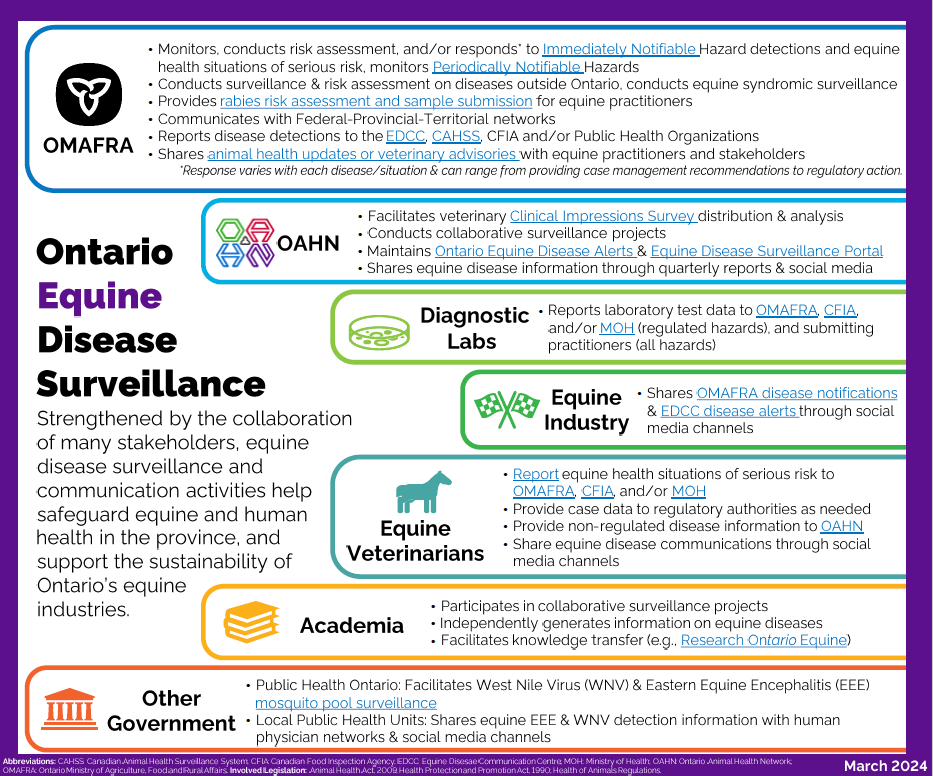
Equine disease surveillance in Ontario is a collaborative effort involving many public and private stakeholders. Diagnostic results generated by veterinary laboratories, clinical impression and case data provided by equine veterinarians, disease detections reported outside of Ontario by independent organizations, vector surveillance conducted by human health agencies, and research projects facilitated by Academic institutions or the Ontario Animal Health Network (OAHN), are all key sources of surveillance data. Strong communication between these stakeholders and with horse owners and caretakers supports both equine and human health in Ontario.
Please follow the links in the summary above for additional information on the associated activities or organizations and for many resources useful to equine industry members.
ResearchONequine.ca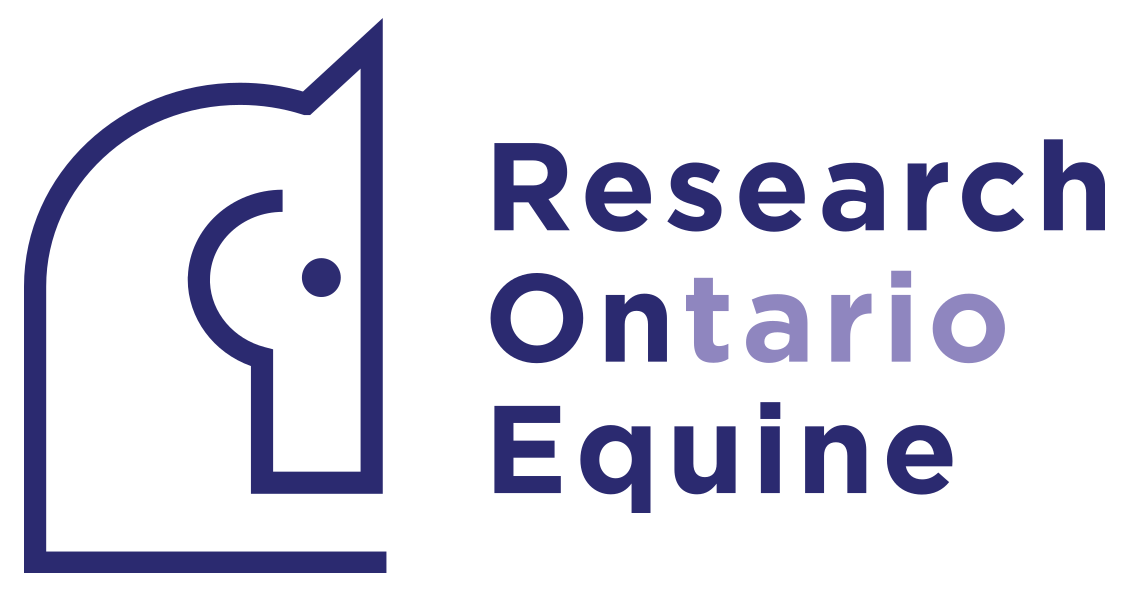 is a website developed by the Ontario Animal Health Network equine network to help increase research awareness and to connect researchers from academia, industry and government with the ultimate goal of improving the lives of all equines. It was supported by OAHN and the Ontario Association of Equine Practitioners.
is a website developed by the Ontario Animal Health Network equine network to help increase research awareness and to connect researchers from academia, industry and government with the ultimate goal of improving the lives of all equines. It was supported by OAHN and the Ontario Association of Equine Practitioners.
